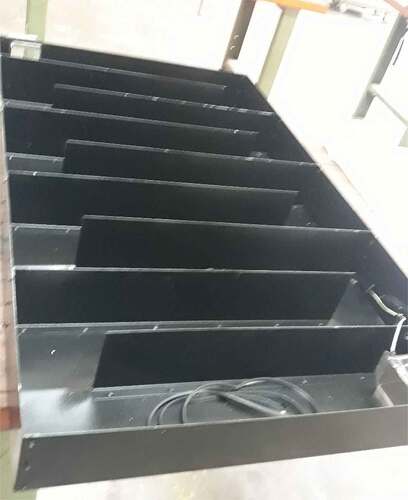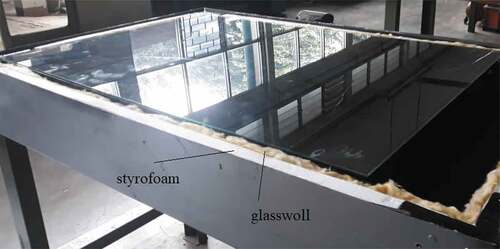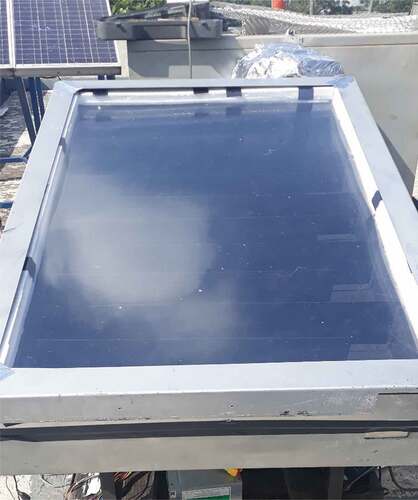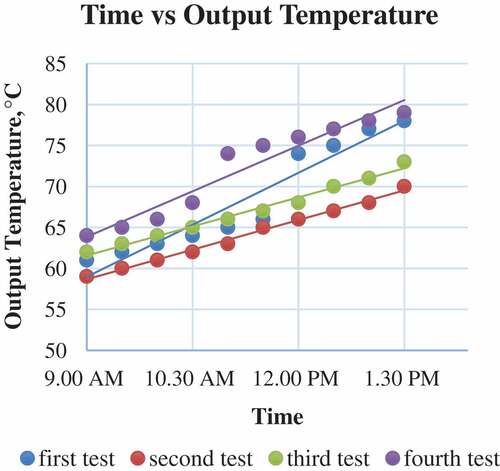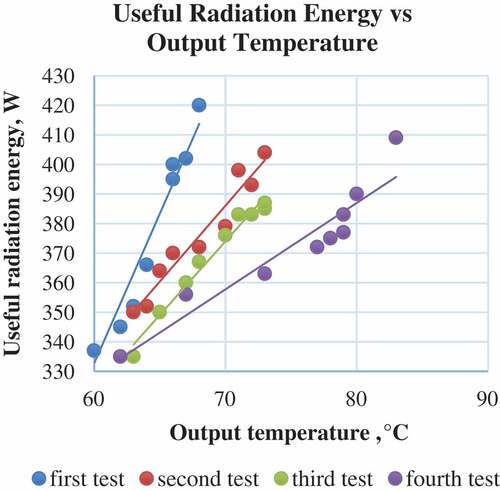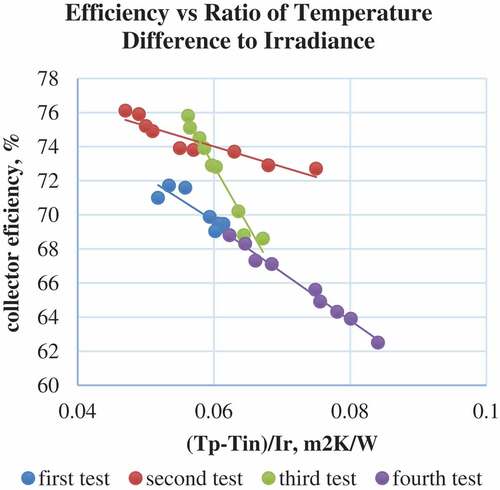 ?Mathematical formulae have been encoded as MathML and are displayed in this HTML version using MathJax in order to improve their display. Uncheck the box to turn MathJax off. This feature requires Javascript. Click on a formula to zoom.
?Mathematical formulae have been encoded as MathML and are displayed in this HTML version using MathJax in order to improve their display. Uncheck the box to turn MathJax off. This feature requires Javascript. Click on a formula to zoom.Abstract
A solar collector that collects solar radiation from the sun is equipped with a heat absorber kit that can store heat for a long term. This system consists of collector box, acrylic-coated cover, black-coated-aluminum base, and finned absorber. The purpose of using the fin is to enlarge the surface area exposed to the sun’s heat so that radiation heat transfer increases. This design is conducted for 460 W collector capacity, 1 m2 surface area, expected output temperature between 60°C and 77°C. Flat-plate solar collector is used for heating the solar-energy-absorber plat. Furthermore, air is passed through the collector to become hot and flowed into the process room by using a fan. Tests are carried out four times, then the results for the lowest and highest output air temperature are 59°C and 77°C and the lowest and highest collector efficiency are 62% and 76%.
PUBLIC INTEREST STATEMENT
Solar energy is one of the alternative energy needed by the community. Besides, being widely available in nature (especially in Indonesia), it is also an eco-friendly energy and a free energy source. For the advantages possessed by solar energy, it is necessary to carry out a large-scale solar energy conservation. One of the examples is the manufacture of solar collectors that can be used for heating water. There have been many solar collector fabrications, in this research, there are fins on solar collector which is made this different. These fins provide an additional area of heat transfer which ultimately increases efficiency. This solar collector is quite simple, so people can make it and use it for daily energy needs. This type of solar collector has advantages such as utilizing both components of solar radiation through direct lighting, does not require sun tracking, and only requires a little maintenance and low manufacturing costs. The test results obtained the lowest efficiency of 62% and the highest efficiency of 76%.
1. Introduction
As technology advances, the need for energy sources increases. This causes people looking more for energy sources, especially for alternative energy. The most abundant one among all renewable sources is solar energy because the sun is an almost unlimited energy source and will not run out as an energy source compared to other energy sources. The sun is almost a constant source of energy. Each day, the sun bathes the earth in unimaginable amounts of solar energy, most of which comes in the form of visible light (Jebaraj & Srinivasa Rao, Citation2015).
Indonesia located on the equator which has a relatively constant high radiation intensity every year is supposed to utilize it as one of the major energy sources. Solar energy is an energy source that does not emit harmful carbon emissions that contribute to climate change. Moreover, this source does not emit nitrogen oxides or sulfur dioxide so that it can be used as a little pollution alternative energy source. The energy produced by each watt has reduced the use of fossil fuels, thereby it is reducing the impact of climate change. Recent research states that every year the average solar home system can reduce 18 tons of gas emissions in the environment.
The solar collector is used to increase the heat produced by absorbing heat from the sun and distributing it to an intermediate substance, namely the air used for a process such as the drying process. Considering the heating requirements and environmental conditions, three types of solar thermal collectors are employed, such as flat-plate collector, evacuated tube solar collector and concentrated solar collector (Bhowmik & Ruhulamin, Citation2017).
An extensive literature review has been carried out for the research in the field of solar collectors. The study of flat-plate solar thermal collectors, with black chrome-plated absorber panels of 0.5 × 0.5 m, was tested under the solar simulator, obtained solar collector efficiency of 30−60% (Moss et al. Citation2018).
The collector uses a reflector with a high solar intensity of around 430 W/m2, the maximum temperature of the collector’s output with a reflector is 50°C and an efficiency of 61% (Bhowmik & Ruhulamin, Citation2017). The efficiency achieved in a solar oven with a parabolic collector was 53.62% (Jebaraj & Srinivasa Rao Citation2015). A solar collector using CO2 can heat water to a temperature of 54°C (Vijayarahavan & Navaneetha Krishnan, Citation2015). The performance shows that the efficiency is 59.09% when increasing the number of riser tubes and its 62.90% in the zig-zag arrangement (Z-configuration) of the riser tube (Sivakumar, Christraj, Sridharan, & Jayamalathi, Citation2012). The absorber of solar collector made by steel plate with an area of 2 × 1 m2 and thickness of 0.5 mm in the form of window shade has been developed for increasing the air contact area obtained an efficiency of 64.9% (Hematian, Ajabshirchi, & Bakhtiari, Citation2012).
The type of collector used in this study is a fin plate collector with an upward direction which involves the use of a flat-plate solar collector in line with the air working fluid. The reason for choosing this type of collector is because the area of heat absorption is wider, so that the surface area of heat transfer from the absorber to the working fluid is also wider. Air flowing with a certain mass flow rate above the absorber plate out of the collector is becoming heated faster than the flat-plate without fins.
2. Design
2.1. Solar collector
Solar collector as a part of the equipment can produce heat energy by utilizing solar radiation energy as the main source. Sunlight will hit the absorber plate, then the light received will mostly be absorbed and converted to heat energy and some of the light will be reflected back into the environment. The heat energy transferred to the fluid flowing in the solar collector will be utilized for various applications, such as the process of drying and water heating.
Flat-plate solar collectors have the advantage of utilizing both components of solar radiation through direct and distributed exposure. The design is simple and does not require sun tracking, and only requires a little maintenance and low manufacturing costs. This type of collector is generally used for heating the room inside the house, air conditioning, and heating processes in the industry. This type of collector is designed for applications that require heat energy at temperatures below 100°C (Sarkar, Citation2013). The specifications of this type are indicated by an absorber in the form of a flat-plate with a material that has a high thermal conductivity value and is coated with black paint. The general application of this type of collector works for water heaters, air conditioning, building heating, and industrial heat processes.
Solar Radiation Energy Calculation (Culp, Citation1979):
Solar Time
Difference in time between real solar time called apparent solar time (AST) and mean solar time is called time equation. Time equation has a correction value varying from about +16.3 min in November to 14.4 min in February. It depends on the position of meridian and latitude. These factors are highly needed at this planning stage.
where AST is Apparent Solar Time; MST is Mean Solar Time, east or west longitude obtained from the building location = local standard time ± [east longitude (+) or west longitude (−) from standard meridian] (4 min) = (Local day time—1:00) ± [east longitude (+) or west longitude (−) of standard meridian] (4 min); time EquationEquation 4(4)
(4) minutes is one rotation in 24 h = [24(60)/360].
b. Solar Angle
where β1 is the position of the sun (the angle between the sun and the line horizontal to the earth) (°); δ is declination angle (°) (0° for spring +23,45° for the solstice (summer), −23,45° for the solstice (winter); L is Latitude (°) τ and H is 0.25 [number of minutes before (−) or after (+), AST] (°).
(c) Azimuth Angle
where α1 is azimuth angle (°).
(d) The angle between sun and surface vertical line (Ɵ)
(e) Hour Angle
If AST < 12, so – 12:00. Then, if AST > 12, so + 12:00.
(f) Direct Normal Radiation Intensity (IDN)
where A is the apparent solar irradiation at air mass zero (outside the earth’s atmosphere), W/m2 and B is the atmospheric extinction coefficient in units of (standart atmosphere)−1 (ASHRAE, Citation1974).
(g) Total Solar Energy Current
where Fss is angle factor between surface and the sun (dimensionless) and C is Ratio of diffusion to solar radiation (dimensionless).
(h) Angle factor between surface and the sun (field surface angle factor)
2.2. Heat balance
Energy balance of the flat-plate collector at the steady state, namely:
where Ac is Collector area (m2); (τα)e is effective transmittance absorption product (dimensionless); QL is the power loss to the surrounding (W) and Qu is the total useful energy collection rate (W).
2.3. Heat transfer
Effective Transmittance-Absorptance Product
where α is solar energy absorptance (dimensionless) and ρ is reflectance/reflection of the cover plate (dimensionless).
(b) Transmittance of the cover plates
Then, and
is given by:
where Kt is extinction coefficient of the glass (dimensionless); θ1 is incidence angle (°); θ2 is refraction angle, obtained from Snell Law (°); N is the number of glass cover (dimensionless) and τ is transmittance of the cover plates (dimensionless).
(c) Useful air energy total from collector
where is useful heat collected from collector (W);
is the mass flow rate of the fluid (kg/s) and cp is the specific heat of the fluid (J/kg °C).
(d) Overall Convection Heat Loss Coefficient
where UL is the overall convection heat loss coefficient (W/m2 K) and A is apparent extraterrestrial isolation (W/m2).
The overall convection heat loss coefficient is defined as the level of heat loss from the collector’s total unit area with the difference in temperature between the absorber and ambient plates ( (Dixon & Leslie, Citation1978) namely:
where Ub is the bottom overall heat loss coefficient (W/m2 K); Us is the side overall heat loss coefficient (W/m2 K); UT is the top overall heat loss coefficient (W/m2 K); Ta is an ambient temperature (°C); εg is the infrared emissivities of the glass (dimensionless); εp is the infrared emissivities of the plate (dimensionless) and hw is the convection coefficient between the top over and the atmosphere air heat transfer coefficient (W/m2K); is the thickness of styrofoam insulation (m);
is the thickness of glasswoll insulation (m).
Combined free and forced convection heat transfer from collector cover posed to the atmosphere (Dufie & Beckman, Citation1974):
where v is the measured air flow rate using digital anemometer, moreover dimmer is used to keep the air entering into the collector constant. The useful radiation energy rate from a flat-plate solar collector is energy that can be used for a process. The useful energy rate of a solar collector can be calculated by the equation:
So, to calculate the efficiency of a solar collector the following equation is used:
2.4. Search and methods
In the making of solar collectors, it is necessary to calculate the energy balance, namely the equilibrium between solar energy that will be absorbed by the collector to the amount of energy needed (drying or heating water). The solar energy absorbed by the collector is calculated in stages, that is, from solar radiation to the collector until to convection which is used for the process. The calculation stages until the manufacturing can be seen in the Figure .
Absorber using fins can be seen in Figure , in this research, a different type of solar collector which is occupied with fins where these fins provide an additional area of heat transfer which ultimately increases the efficiency (EquationEquations 25(25)
(25) and Equation26
(26)
(26) ). The insulation layer is shown in Figure , the purpose of using the insulation is to reduce heat loss (EquationEquation 22
(22)
(22) ) and the solar collector with its cover is described in Figure .
3. Results and discussions
3.1. Relationship between testing time and output temperature
From the design, the dimensions of a solar collector gained which is composed of 4 layers: iron, styrofoam, glass wool as an insulator and aluminum plate as heat absorbers is 110 cm x 75 cm x 15 cm, while the fin size is 50 cm x 10 cm x 1 cm as much as 8 fins, made of aluminum plates arranged in a zig-zag. Values of temperature input, temperature output, plate temperature and air velocity (EquationEquation 24(24)
(24) ) are obtained from the test results, i.e. 3.6 m/s. The air velocity value affects the value of the air heat transfer coefficient, which in turn affects the overall heat transfer coefficient at the top of the collector. The function of temperature is to find the properties of air and to calculate the value of the useful radiation energy rate, the heat transfer rate of air and the efficiency of the collector.
Figure shows that from all tests the radiation intensity value reached its peak for the testing at 1:30 PM. Furthermore, the highest temperature output is of 77°C on the fourth test. This value is better than the value achieved in the previous research, namely 53°C (Bhowmik & Ruhulamin, Citation2017), 54°C (Vijayarahavan & Navaneetha Krishnan Citation2015), and 62°C (Sivakumar et al. Citation2012).
3.2. Relationship between useful radiation energy and output temperature
The useful radiation energy reached a peak of 420 W at 67°C on the first test followed by the value of 108 W at 84°C on the fourth test as shown in Figure . It can be concluded that the radiation intensity varies so the heat absorbed by the air is also different. The intensity of the sun’s heat is always changing, where the peak intensity of sunlight occurs at 11:30–12:50 h. Before and after the clock has decreased so that the conservation of energy law applies. It means that the amount of energy emitted by the sun decreases or changes, then the heat absorbed by the air also decreases or changes (Brownson, Citation2014)
3.3. Relationship between useful radiation energy and efficiency
The efficiency value depends on the intensity of solar radiation received by the collector, the ambient temperature and the wind speed around the collector. The calculation of the efficiency of a solar collector also depends on losses, namely heat loss at the top of the collector, at the bottom of the collector and on the side of the collector. The biggest total heat loss that occurs is at the top of the collector.
According to Figure , the highest efficiency gained from the research was 76% on the second test. This result is higher compared to the highest efficiency achieved in the other four studies. The efficiency values of using reflector (Bhowmik & Ruhulamin, Citation2017), parabolic solar collectors (Jebaraj & Srinivasa Rao, Citation2015), super-critical carbon dioxide (Sarkar, Citation2013) the collector in natural convection (Hematian et al., Citation2012) are 61%, 58%, 74% and 67%, respectively.
The efficiency comparison of flat-plate solar collectors using fins, flat-plate solar collectors (Amir Hemation, et al., Citation2012) and solar oven with parabolic dish (Jebaraj & Srinivasa Rao, Citation2015) are tabulated in Table .
Table 1. Efficiency in various types of solar collectors
The values of collector efficiency are fluctuating because it is influenced by several factors: the average input and output temperatures and the intensity of radiation, as shown in Figure . The input and output temperatures of the collector have an effect on the efficiency of the collector because if the difference in air temperature in the collector with the ambient temperature is greater, the collector tends to release more heat so that efficiency decreases.
Conversely, if the difference in air temperature inside the collector with the environment temperature is smaller, the collector releases less heat so that the efficiency increases. The ratio of the difference between temperature and irradiation of 0.049 m2K/W shows an efficiency of 75% close to the results of the study of solar collectors using CO2 which is at 0.047 m2K/W showing an efficiency of 74% (Sarkar, Citation2013). It Corresponds to an increase in aperture efficiency from 0.3 to 0.6 at (Tp-Tin)/Ir = TM/G = 0.06 m2K/W (Moss et al. Citation2018).
The higher the irradiance is the lower Tp increment occurs when Tin value is nearly constant. By the significant increase in Irradiance, Qu value experiences significant rise. While UL value only got a slight increase and in the end improved the efficiency.
4. Conclusions
The prototype of a flat-finned tetragon solar collector was built and tested at Politeknik Negeri Bandung, Indonesia. The study was conducted in July 2018 which is located in the geographical location of 107° 11 ‘06 “to 107° 27ʹ 58” East Longitude and 6° 41 ‘12 “to 7° 07ʹ 09” South Latitude and 700–730 m high above sea level.
The results of the observations show that the efficiency of the collector is very dependent on the intensity of solar radiation. Another factor is the loss of radiation intensity, to minimize the heat lost from the collector to the environment, on the back and side of the collector, two layers of insulation are used, namely styrofoam and glass wool, and the addition of fins to maximize the efficiency of the collector. The efficiency obtained is 76%, this value is 18% above the parabolic solar collector and 2% above the collector using supercritical carbon dioxide fluid.
Additional information
Funding
Notes on contributors
Sri Wuryanti
Sri Wuryanti was born in Indonesia on March 26th, 1965. She received the Ir. degree in Chemical Engineering from Institut Teknologi Sepuluh November (ITS), Surabaya, Indonesia in 1990 and M.Sc. degree in Chemical Engineering from Institut Teknologi Bandung (ITB), Bandung, Indonesia in 1994. Since 1990, she has been a Lecturer in Department of Energy Conversion Engineering, Politeknik Negeri Bandung, Bandung, Indonesia. She is currently pursuing the doctoral degree at the Department of Physics, Universitas Indonesia (UI) Indonesia 2015. Email: [email protected]
Megawati was born in Indonesia on April 24th, 1997. She received the S.T. degree in Energy Conversion Engineering from Politeknik Negeri Bandung (POLBAN), Indonesia in 2018. Since 2018, she has been a technician in Department of Energy Conversion Engineering, Politeknik Negeri Bandung, Bandung, Indonesia. Email: [email protected]
Megawati
Sri Wuryanti was born in Indonesia on March 26th, 1965. She received the Ir. degree in Chemical Engineering from Institut Teknologi Sepuluh November (ITS), Surabaya, Indonesia in 1990 and M.Sc. degree in Chemical Engineering from Institut Teknologi Bandung (ITB), Bandung, Indonesia in 1994. Since 1990, she has been a Lecturer in Department of Energy Conversion Engineering, Politeknik Negeri Bandung, Bandung, Indonesia. She is currently pursuing the doctoral degree at the Department of Physics, Universitas Indonesia (UI) Indonesia 2015. Email: [email protected]
Megawati was born in Indonesia on April 24th, 1997. She received the S.T. degree in Energy Conversion Engineering from Politeknik Negeri Bandung (POLBAN), Indonesia in 2018. Since 2018, she has been a technician in Department of Energy Conversion Engineering, Politeknik Negeri Bandung, Bandung, Indonesia. Email: [email protected]
References
- ASHRAE. (1974). American society of heating, refrigeration and air conditioning engineers. New York, NY.
- Bhowmik, H., & Ruhulamin. (2017). Efficiency improvement of flat plate solar collector using reflector. Energy Reports, 3, 119–12. doi:10.1016/j.egyr.2017.08.002
- Brownson, J. R. S. (2014). Solar energy conversion systems. Oxford: Academic Press.
- Culp, A. W., Jr.. (1979). Priniples of Energy Conversion. Mc.Graw-Hill, Ltd. 86–90.
- Dixon, A. E., & Leslie, J. D. (1978, August 6–19). Solar energy conversion, An Introductory Course, 121–123.
- Dufie, J. A., & Beckman, W. A. (1974). Solar energy termal processes. New York, NY: Wiley Interscience.
- Hematian, A., Ajabshirchi, Y., & Bakhtiari, A. A. (2012). Experimental analysis of flat plate solar air collector efficiency. Indian Journal of Science and Technology, 5(8), 3183–3187.
- Jebaraj, S., & Srinivasa Rao, P. (2015). High-efficiency solar oven for tropical countries. Arpn Journal Of Engineering And Applied Sciences, 10(21), 10213–10217.
- Moss, R. W., Henshall, P., Arya, F., Shire, G. S. F., Eames, P. C., & Hyde, T. (2018). Simulator testing of evacuated flat plate solar collectors for industrial heat and building integration. Solar Energy, 164, 109–118. doi:10.1016/j.solener.2018.02.004
- Sarkar, J. (2013). Performance of a flat-plate solar thermal collector using supercritical carbon dioxide as heat transfer fluid. International Journal Of Sustainable Energy, 32(6), 531–543. doi:10.1080/14786451.2013.833205
- Sivakumar, P., Christraj, W., Sridharan, M., & Jayamalathi, N. (2012). Performance improvements study off solar water heating system. ARPN : Journal of Engineering and Applied Sciences, 7(1), 45–49.
- Vijayarahavan, R., & Navaneetha Krishnan, P. (2015). Experimental and comparative study on solar water collector using CO2. Journal Of Chemical And Pharmaceutical Sciences, 6, 228–229.


